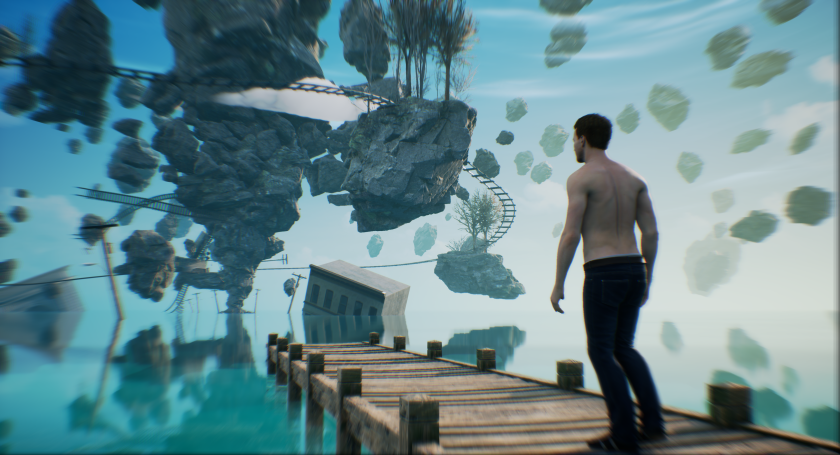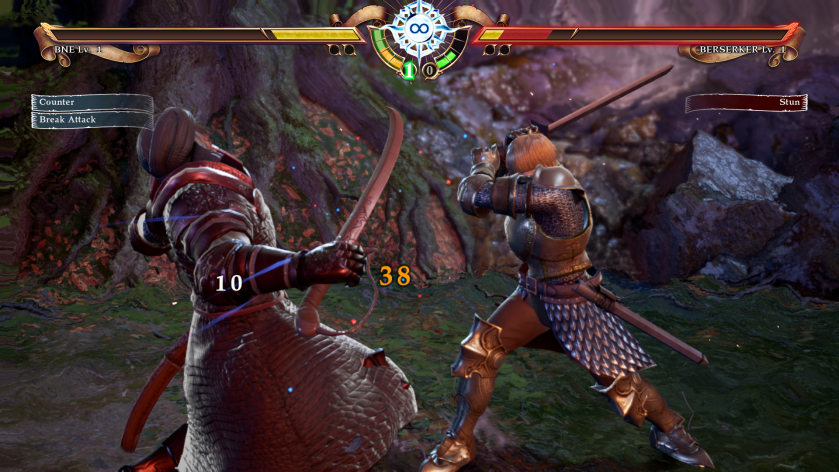As desperate as I was to be there this year, gamescom 2018 just wasn’t a possibility. Sometimes the realities of life override the role I take as a member of the enthusiast press. This meant I spent a week bitterly scrolling social media, watching everyone have an awesome time whilst I was stuck in the UK.
Fortunately for me, Bandai Namco offered those of us who couldn’t make it to gamescom the chance to play the games available on the show floor in the tranquillity of their office in Richmond. I’ve actually already been to one of these press junkets approximately a year ago, but this was the first foray into games journalism for my ‘new hire’, Tim.
Sadly the giant Pacman machine that I set a high score on during my last visit wasn’t present. In its place was a delightfully macabre statue of a skull, promoting one of the eight games playable at the showcase, The Dark Pictures: Man of Medan. Incidentally this was the first game I played.
Coming from Until Dawn developer Supermassive Games, Man of Medan is the first of an anthology series titled The Dark Pictures. This reminds me a lot of a hidden object horror anthology series I used to play called Campfire Legends, so I’m hoping Dark Pictures will be just as enjoyable.
Man of Medan takes place on an abandoned ship which, as the protagonists discover, is filled with the undead. There wasn’t much by way of gameplay – it felt more like a tech demo than a game – but what the demo lacked in comparison to more action-heavy games, it certainly made up for in atmosphere. The groaning wreck is dark and eerie; the tight corridors are filled with rust and stagnant puddles and there’s an awesome sense of foreboding about what could be around the next corner. Tim experienced some texture issues, and we both felt the controls needed polishing, but our consensus is that this has the potential to be a fantastically terrifying game, reminiscent of old-school survival horror.
Having played it first, Tim described One Piece World Seeker as ‘Japanese AF’, which is a fairly apt description considering it’s based on the One Piece anime. Players assume the role of rubber-limbed Monkey D Luffy as he explores a colourful open world, an island ravaged by war. The art design reminded me in particular of Ni No Kuni, similarly bold and bright.

However, whilst the world is vast and interesting and the combat mechanics themselves are fun, the gameplay is repetitive and rapidly becomes a little tedious. What’s more, enemies respawn, meaning if you slip off a cliff and end up on the path below, you’ll have to fight the five guards you just defeated once again to reach the spot you were at previously. This, factored with the apparent inability to lock-on to enemies and the loose controls made what should have been an enjoyable experience an unnecessary annoyance. It was confirmed in an interview during gamescom that earned ability points could be used to upgrade existing abilities and unlock new ones, so hopefully this should take some of the monotony out of it, but with release not too far away it’s slightly worrying to feel like so much polish is still needed. We’ll just have to wait and see.
Next up for us both was 11-11: Memories Retold. Now, the only way I could accurately describe this to people if they hadn’t seen any promotional material would be to say it’s like playing an oil painting. The art style is so beautiful and unique that it’s impossible to fully appreciate if it’s not in motion; screenshots look like concept art. Whilst I did really love it, it was Tim who was truly blown away by 11-11 – to the point where he’s written an in-depth article about it – and it’s easy to see why.

Set during World War One the game follows two concurrent storylines, flitting between each at various intervals. One story is that of Harry, a young photographer from Toronto, the other is that of Kurt, a worker in a zeppelin factory in Germany, both of whom end up serving in the trenches. Harry is tasked with photographing the war as experienced by a British Army general, and Kurt enlists in order to find his son after learning he is among several officers from his regiment listed as MIA. During an incredibly heart-pounding sequence, players take control of first Harry as he goes over the top and traverses No Man’s Land and then Kurt as he fetches ammunition and water for his fellow soldiers. With bullets flying left and right, Harry’s fear of death at the hands of the enemy is palpable, something which is taken up to eleven when he and Kurt find themselves in the tunnels beneath the trenches face-to-face. Suffice it to say we were both wide-eyed when we’d finished the demo.

Of the four games available on that particular machine, Twin Mirror was the one I saved for last. I’ve been intrigued ever since the trailer during Bandai Namco’s E3 presser. Developed by Life is Strange devs Dontnod Entertainment, Twin Mirror tells the story of Sam Higgs, one of the most unsympathetic protagonists we’ve ever played as. Waking up hungover in a hotel room, Sam tries to piece together his drunken night after discovering his bloodied shirt in the bathroom; he’s not bleeding, so whose blood is it?
In order to reconstruct his memory Sam must retreat into his mind palace where he constructs a sort of simulation he can manipulate. Options for his movements or interactions can be watched or altered, and players can shift into the real world to look for clues that might help him solve his mystery. Initially I couldn’t think of what the mind palace reminded me of aesthetically but I’ve now realised: it’s very reminiscent of the Void from Dishonored.

Tim wasn’t as gripped by Twin Mirror as I was, but colour us both intrigued. Sam is an unsympathetic drunk, who came face-to-face with a garishly-dressed double of himself. It’s clear he’s a figment of Sam’s imagination but is this because he’s simply insane, or does he have a split personality? Seeing as the double appears fairly prominently in the promotional artwork for the game I’ll hazard a guess he’s going to play a significant role. Maybe this will be another exploration of mental illness, continuing what is a growing trend. The first of three episodes is set to release next year.
Venturing back out into the main area Tim got a hold of Soulcalibur VI, only after I had displayed my immense lack of skill at fighting games by having Geralt of Rivia, this instalment’s guest character, repeatedly beaten up and booted out of the ring by Xianghua. I did, however, manage to win one round by blasting her with Igni and then subjecting her to the wrath of my sword, so at least I have that going for me. I am not ashamed to say I’m not a fan of fighting games purely because I suck at them, although for what my opinion would be worth, Geralt’s fighting style had been captured to a tee. It was genuinely as though he’d been plucked from The Witcher 3 and thrown into a ring. He is quite slow to move and attack, but deals hefty damage.

Decidedly more of a fighting game expert than me (and a long-time Soulcalibur fan), Tim made it his mission to play as every character on the roster by the end of the evening. He was very impressed with Grøh, one of two new characters introduced in VI, in particular his side kicks. In fact, he describes the animation and character design as ‘very cool’, and particularly enjoyed the new mechanic where time would slow to a crawl, broken by the first person who manages to block or attack (I don’t remember seeing this, but then I probably didn’t press the right buttons to trigger it).
Although we did play both playable missions for Ace Combat 7, we found ourselves bored by it. I played the VR build that was available the previous junket I attended and found it surprisingly enjoyable, despite my relative inability to use PSVR as a visually impaired person. Perhaps it’s a game that can only really be enjoyed when fully immersed, or perhaps it’s purely that it’s just not our cup of tea. Either way, it wasn’t a game we lingered on.

Though we didn’t get a chance to play Jump Force as there were only two available machines, we did go head-to-head in My Hero One’s Justice – I politely declined Tim’s challenge of playing 1v1 in Soulcalibur because I knew I’d be beaten instantly and I’m a terrible loser.
Based on superhero manga/anime My Hero Academia, this is my kind of fighting game. It’s crazy, it’s zany, it’s bright and silly. Picking a main character and two sidekicks from the roster, players then brawl in a 3D environment that’s totally destructible. As in the source material, characters are Quirks, people born with superpowers. These powers can be utilised to great effect during fights which, combined with destructible environments is a recipe for pure fun and carnage. The visuals are incredibly bright and have a distinctly comic book feel which suits what I’ve seen of the source material perfectly – I am not the best person to talk about this, however. Tim, ever the serious martial artist, wasn’t particularly impressed with how silly it was and immediately voiced his preference for Soulcalibur and Tekken (I won almost every fight against him, which I’m sure had nothing to do with his comments whatsoever).

And just like that it was over all too soon, as is the case with any gaming event. We left with some stylish Twin Mirror postcards, buzzing with conversation about the past few hours (in Tim’s case this was mostly just 11-11). Thanks a lot to Bandai Namco for having us for the afternoon, for giving Tim his first taste of life as a games journalist, and for giving us so much awesome content to look forward to in the coming months.
